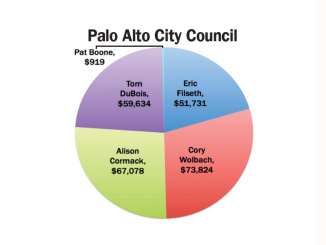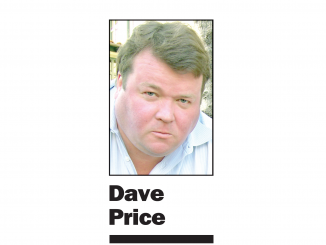
BY KYLE MARTIN
Daily Post Staff Writer
Palo Alto’s Castilleja all-girls school last night moved a step closer to getting city approval of its redevelopment plans that have been fought by neighbors for the past five years.
City Council unanimously agreed to send the proposal back to the Planning and Transportation Commission for changes. Then it will return to council for a final vote.
One thing council wants the PTC to consider is a smaller alternative to the 78-space parking garage Castilleja wants to build under the playing field facing Embarcadero Road.
Council, in a 4-3 vote, asked the PTC and Planning Department to study the idea of a 52-car garage. Lydia Kou, Greer Stone and Mayor Tom DuBois voted against the motion and were the three council members the most opposed to the project last night.
The project at 1310 Bryant St. is required to have 104 spaces.
With 52 spaces underground another 52 would have to be on the 6-acre campus or at a satellite location, where drivers would be shuttled into and out of the school.
Mindie Romanowsky, a lawyer for Castilleja, didn’t sound interested in the satellite parking idea and insisted that the city code required the cars to be parked on campus.
And she didn’t appear to welcome the changes council wanted the PTC to examine, although it was unlikely that the project would be approved without them.
“There are material changes that you are suggesting to our project that have very strong implications for the project,” said Romanowsky. “I’m concerned that some of the language in this motion goes far beyond the environmental analysis and the impacts that were identified by the consultants.”
Enrollment linked to traffic promises
Council voted to also have the PTC come up with a procedure that links the school’s enrollment growth to its compliance with traffic reduction measures. In other words, Castilleja — which previously violated its conditional use permit by enrolling too many girls — would have to follow a plan to limit the traffic the school creates, or it couldn’t grow its enrollment.
Neighbors have opposed the redevelopment saying it would result in more traffic and that the new buildings would be out of scale for a neighborhood of single-family homes.
The school now has 426 students and wants to eventually have 540 pupils.
No new net car trips
Councilman Eric Filseth asked that the city be able to enforce a standard of no new net car trips. If the term “no new net car trips” sounds familiar, it’s because Stanford has been under such a requirement for years.
“I think the combination of enrollment and monitoring enforcement of traffic in the neighborhood — it needs to be results-based as opposed to effort-based,” Fisleth said.
Councilman Greer Stone said, “I agree our response needs to be measured but still strict enough to show that we mean business when enforcing these rules.”
Stone said he wants to be able to enforce stringent rules on the school’s enrollment and traffic impact on the neighborhood, and that if the school over-enrolls again or if parking gets out of hand, the city can step in to change that.
“Otherwise, this is a massive project that I don’t think is appropriate to approve simply on hoping for best results,” Stone said.
DuBois against underground garage
Mayor Tom DuBois said he would have rather the council had just denied the underground parking garage outright, and said “I think there’s substantial evidence to support denying this project.”
Denying the underground garage would likely kill the project.
DuBois also wanted to enact strict enforcement measures on the school’s enrollment expansions.
“I really think it needs to be a much simpler commitment to meet these conditions of approval with a clear fine, clear penalty schedule,” DuBois said.
Students driving to school
DuBois and Vice Mayor Pat Burt agreed that they should try to limit how many students drive to the school to limit car trips.
Burt suggested the school prohibit juniors from driving to campus and asked that the school find ways to encourage carpooling.
Burt also suggested that the school, which charges $52,000 annually for tuition for grades six through 12, expand its enrollment to more Palo Alto and East Palo Alto students to limit car trips from outside cities to the school.
He asked that the city create an oversight committee of neighbors and city employees to check the school’s compliance with city rules annually.
And on the garage issue, he said “a modest-sized garage is a net plus. An oversized is a negative, no garage is a negative.”
Noise measurement
Councilwoman Lydia Kou suggested the school install microphones or similar devices to measure sound levels. She wants to ensure that neighbors aren’t burdened with too much noise.
“I think all of us actually do want a world-class school in our city. I don’t think there’s any one of us here that doesn’t want that,” Councilman Greg Tanaka said.
He said he agreed with his colleagues who wanted “strict and immediate” penalties for over-enrollment at the school.
He said he was worried the council made its direction to the PTC too complex, particularly the part about the garage.
“It’s like a total reset of this whole project,” Tanaka said. “It’s not like we’re changing a window. It’s like an entirely different project.”
Councilwoman Alison Cormack she supports the school building an underground parking garage of some sort. She said the wished the project wouldn’t result in the elimination of trees.
“I do think there’s been an extraordinary effort on the part of the applicant and the (city) staff to protect as many as possible to move them to the places that work,” Cormack said. “If there are a few at the margin that we need to do more work on, then that’s OK. But I’m not second guessing the staff on this.”




This huge garage is ridiculous, it will draw traffic and crowd the streets. eliminate it. if the project fails because of that, fine. castilleja can sell off the land to a home developer and find a new campus elsewhere. nobody is going to be crying a river over that. they provide absolutely zero benefit to anyone besides their students and faculty.
Fool me once, shame on you. Fool me twice, shame on you. Council should remember this little adage when they consider Castilleja. The school was already caught cheating once on enrollment numbers. Now the city is going to trust them to fulfill the terms of a TDM. Council must be really dumb if they think Castilleja can be trusted. Or maybe council wants to approve this so bad, they think we’re really dumb and will fall for this.
Digging that garage is going to mean the removal of a lot of dirt, in big, loud bulky trucks for God knows how long. The nearby residents will lose a couple years of their life to the noise, dust, closed roads, etc. Council should take this into account.
Fool me once, fool me twice indeed. Speaking of fools, the city “planners” cited traffic studies from 1999! Maybe updating them re the huge increase in population and commuter traffic might be considered as well as the impact of the possible closure of Churchill on Embarcadero traffic. I quickly pulled together numbers showing that the employment at Google alone jumped from 1,907 in 1998 to 135,000 last year (not counting consultants which outnumber employees). FB showed a huge year-over-year jump of 35% per year https://www.macrotrends.net/stocks/charts/FB/facebook/number-of-employees
The city planners cited traffic studies from 1999, more than 20 years ago, It would be special if they updated them before approving this project to show the huge increase in population and commuter traffic might be considered as well as the impact of the possible closure of Churchill on Embarcadero traffic. I quickly pulled together numbers showing that the employment at Google alone jumped from 1,907 in 1998 to 135,000 last year (not counting consultants which outnumber employees).
A garage holding 50 vs 100 cars makes no difference… a big cement bunker to drive cars into will be as impactful either way… and why is it that the legal team is not interested in satellite parking when many other schools such as Nueva upper school have very successfully use satellite parking lots as well as prohibiting students from driving to school during school hours? The fact that the school and their defense team are holding tight to this garage is very troubling since many council members have raised concerns over the impacts to the neighborhood, Bicycle safety boulevard, and the traffic. A school that cares so little about it’s impact to the neighborhood and refuses to consider less impactful options should simply not be allowed to grow at all! The proposed project and increase in enrollment is a burden for the neighborhood, burden for Palo Alto, which as past history shows has not been able to keep watch on the violations to student enrollment, school events and or parking in other neighborhoods which they do not monitor! The city has determined a maximum buildout in year 2000, but they immediately went over that in subsequent years. Who is to say they’ll comply this time around?
Kou wants noise microphones? Who would monitor them? Could they be used to pick up private conversations? How much would it cost? What would that cost be over the long term?